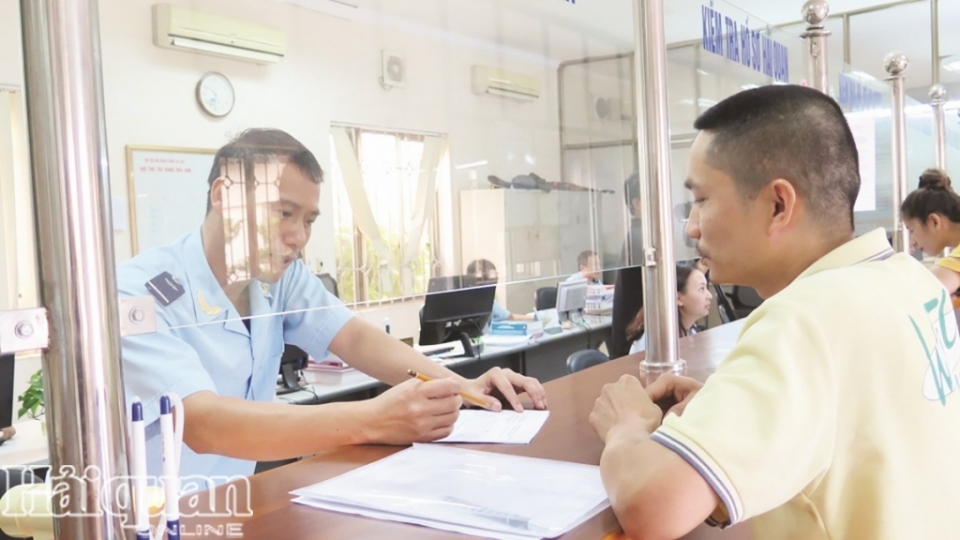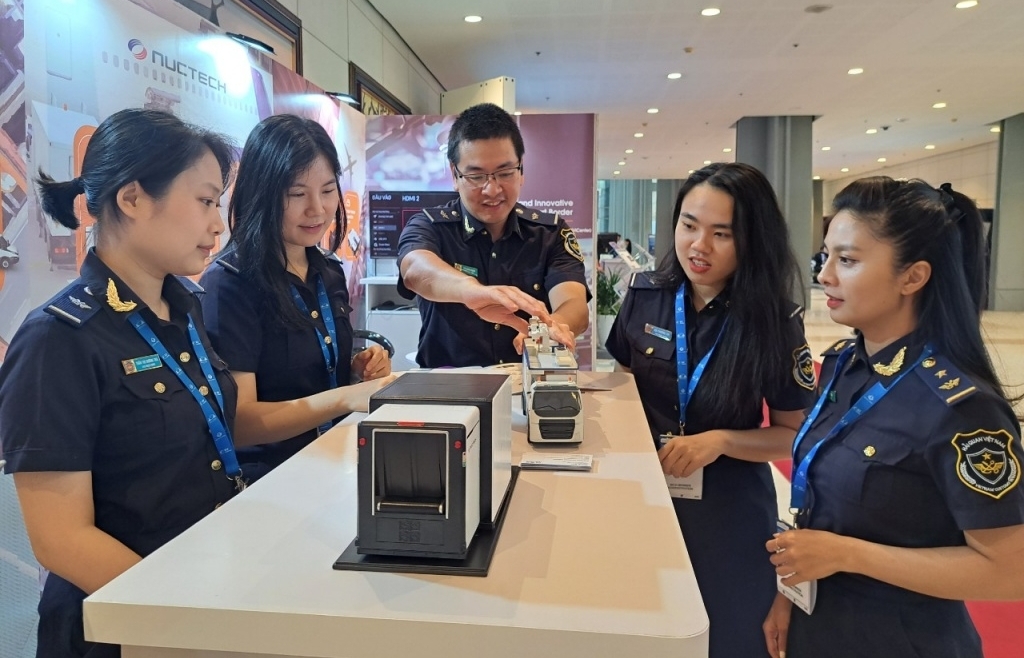Electronic tax payment 24/7: How do enterprises carry out the collection process?
 |
| Professional operations at Cai Lan Port Customs Sub-Department, Quang Ninh Customs Department. Photo: T.Trang. |
How do enterprises benefit from participating?
According to the analysis of Ms. Nguyen Thi Thanh Huong - Deputy Head of the Department of Estimation and Management of Revenue, Import and Export Tax Bureau, in addition to the advantages of electronic tax payment with the upgrading of electronic customs payment gateway to deploy and apply for enterprises who have demand to rely on the Customs authorities for immediately transferring the information of the payable tax each declaration to the banks that the enterprise has authorized to deduct the debt of the tax payment account, there are some following advantages: enterprises do not have to make procedures for making tax payment orders on the Customs Portal or at the bank, which limits all risks when exchanging information to make payment orders between the Customs/banks with order maker.
Enterprises do not have to pay right after declaring, so they mobilize their capital actively, the banks only deduct money from the account of the enterprises right after the enterprises have completed the customs procedures, accurately determine the payable tax, their goods will be declared automatically.
Supporting enterprises to carry out the import and export procedures for goods at auxiliary border gates, trails and tracks without collecting points of banks/the treasuries, without internet network to implement electronic tax payment.
Also according to the representative of the Bureau of Import-Export Tax, with the implementation of the Collection program, enterprises can apply the payment methods such as direct payment at the bank or can use two electronic tax payment programs 24/7 in parallel with the Collection program. However, with the Collection payment method, the enterprises can only register to authorize one account at only commercial bank for a fixed time to ensure automatic processing of the system (should not be sending a payment request to 2 banks because they will not know which bank will make the payment or both banks will transfer the payment order), as well as the bank's management in authorizing the deduction of debt.
About the handling process when the account of enterprises used for deduction is not enough. In case the enterprises authorize the commercial bank but their account lacks the balance to pay, the banks will respond to them through the customs electronic payment gateway;
If the enterprises submits an additional amount to the debit account, it will send the information to the Customs office and continue to pay for the collection. The system of Customs continues to process automatic payment of consignments of tax arrears on the centralized accounting system. If enterprises need to clear the customs procedures at the current shipment, they can make payment by electronic tax payment method 24/7 or directly at commercial banks.
Implementation process
Speaking about the analysis of the implementation process, Ms. Nguyen Thi Thanh Huong said that in the registration process enterprises register to participate in the Collection Program with the Customs office at the function on electronic payment gateway and clearance 24/7 (address: https://epayment.customs.gov.vn/epaymentportal/login).
Next, enterprises register the authorized information to deduct their account when the taxpayers register the information directly at the Customs e-payment gateway or register at the joint-collecting bank which carried out electronic tax payment 24/7.
Carrying out authorizing procedures to deduct accounts with banks holding accounts of enterprises which implemented electronic tax payment 24/7.
The banks holding the account of the enterprises re-send the information that the enterprises have registered to authorize to deduct account at the banks to the General Department of Customs.
The electronic payment gateway and customs clearance 24/7 of the Customs update the information on the system and enterprises complete the registration for participation and registration of debit deduction authorization in the Collection Program.
In the process of implementation, enterprises are allowed to modify the registered information or cancel the registration of authorized debt deduction at one bank to register for debit deduction authorization at other banks. The order of the registration of debit deduction authorization is carried out according to the above steps.
With the payment process, right after completing the registration of debt deduction authorization with the banks, the Customs System will base on the amount of tax arrears and other collection on the tax accounting system to transfer the information of remaining collection to banks to deduct debt from their accounts to pay taxes and other collection for enterprises.
Regarding debt deduction for new arising, the sequence of steps is as follows:
Step 1: Enterprises declare to carry out customs procedures, right after the official declaration (for green flow declaration) or after completing customs procedures, they will determine the exact payable tax for the declaration pending customs clearance updating into the centralized accounting system.
Step 2: Based on the amount of payable tax on the centralized accounting system, based on the list of enterprises participating in the Collection Program, the Customs System will automatically transfer the information of tax arrears arising from each declaration to the banks that the enterprises have authorized to deduct the tax account.
Step 3: The banks base on the account balance of the enterprises and the list of enterprises registered debt deduction authorization, if they are appropriate with the registration information and the balance is enough to deduct, the banks will carry out deducting their accounts and transfer information on the amount of deducted money to the General Department of Customs to pay off debts according to each declaration, details of tax, money transfer and information on payment to accounts of the Customs office at the State Treasury.
In case the account of enterprises is not enough, the banks will respond to the enterprises via the electronic payment gateway and customs clearance 24/7. Enterprises can pay additional money to the account to have sufficient balance for paying the outstanding debts and notify the Customs office via the electronic payment gateway and customs clearance 24/7 to continue processing automatic deductions for declarations which must also be collected in time. Or enterprises can switch to electronic tax payment 24/7 or pay directly at commercial banks/State Treasuries for timely customs clearance
Step 4: Based on information of collected tax and other collection, the centralized accounting system updates information and subtracts the debt details according to each declaration, tax and transfer information confirming the completion of tax obligations to VNACCS to clear goods.
| Conditions of deployment For banks: Must be a bank coordinating with the General Department of Customs to implement electronic payment and customs clearance 24/7. The technology system has been developed to meet the requirements of the Collection program. For enterprises: Register to participate in Collection Program with the Customs; Signed an authorization to deduct debt from the account with the bank holding the account of the enterprise that has implemented electronic tax payment 24/7; Only registered to deduct debt at one bank account. The registered account of debt deduction authorization have enough money to pay when incurring tax debts and other collection. |
Related News

Corporate profits enter recovery cycle
08:46 | 19/05/2024 Import-Export

Build and protect the rice value chain against market fluctuations
19:03 | 19/05/2024 Import-Export

Why director of Saigon Port Import-Export and Services JSC suspended from exit?
09:56 | 18/05/2024 Anti-Smuggling
Latest News

Vietnam Customs affirms its role in the international customs community
08:47 | 19/05/2024 Customs

Resolve arising problems to effectively implement ASEAN Single Window
09:54 | 18/05/2024 Customs

It is necessary to develop separate software for Program of Enterprises complying with Customs Law
20:23 | 17/05/2024 Customs

The Customs agency has a variety of solutions to support businesses
10:00 | 16/05/2024 Customs
More News

Binh Dinh Customs: Set a goal to upgrade administrative reform
09:59 | 16/05/2024 Customs

The first exam for certificates of training in customs in 2024 is going to take place
09:57 | 16/05/2024 Customs

Establishing a board of project implementation on building an IT system to implement digital customs
11:33 | 15/05/2024 Customs

Ha Nam Ninh Customs Department promotes dialogue and removes difficulties for enterprises
12:10 | 14/05/2024 Customs

Deputy Director General Nguyen Van Tho works with FedEx leader
12:10 | 14/05/2024 Customs

Customs revenue rises thanks to 3 imported groups
10:14 | 14/05/2024 Customs

Quang Ninh Customs promotes development of Customs broker
10:12 | 14/05/2024 Customs

Customs deploys 132 full-online public services
13:30 | 13/05/2024 Customs

Vietnam Customs directs to follow the progress of aviation projects closely
13:28 | 13/05/2024 Customs
Your care

Vietnam Customs affirms its role in the international customs community
08:47 | 19/05/2024 Customs

Resolve arising problems to effectively implement ASEAN Single Window
09:54 | 18/05/2024 Customs

It is necessary to develop separate software for Program of Enterprises complying with Customs Law
20:23 | 17/05/2024 Customs

The Customs agency has a variety of solutions to support businesses
10:00 | 16/05/2024 Customs

Binh Dinh Customs: Set a goal to upgrade administrative reform
09:59 | 16/05/2024 Customs




